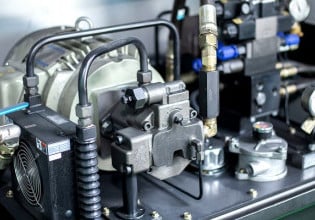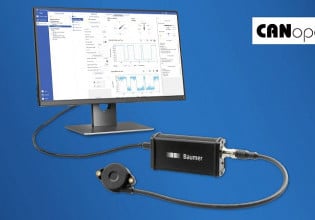Precision Liquid Handling Robot Systems
In this article, we look at the liquid handling robots capable of handling high-precision liquid requirements.
High-precision fluid dispensing has applications in a wide variety of industries where there is a requirement for high precision and accuracy that are critical for processes. This requirement is pronounced in electronics manufacturing and life sciences laboratory applications.

A robotic pipetting arm. Image courtesy of Andrew Alliance.
Such applications require fluids to be dispensed in the range of microliters (μL) with tolerances in the nanoliter (nL) range. Such processes also need to demonstrate high levels of reproducibility to have a parallel.
What are Liquid Handling Robots?
Liquid handling robots are used for workflow automation in industries where there is a requirement for high-precision fluid dispensing. In such instances, the same processes are repeated over and over.
Humans cannot maintain reproducible and reliable results over a large number of samples. Such processes can be automated to produce reliable results and to eliminate spending manpower for repeatable and mundane tasks.
In life science laboratories, processes like sample preparation, serial dilution, DNA preparation, normalization are steps that are repeated multiple times and they are also common steps involved in a wide variety of experiments. Such processes can be easily automated with liquid handling robots to achieve high efficiency and free up manpower for more intellectual tasks.
Another repetitive task in a laboratory is to wash the microplates that hold samples and reagents. For this task precision is not as important as thoroughness, still, such robots are classified as liquid handling robots.
Other than automating repetitive, mundane tasks, the two major benefits of using liquid handling robots are to achieve reproducibility and traceability.
Reproducibility
Reproducibility is a major principle in scientific experiments, it is the same case for laboratory experiments. Reproducibility is the ability to obtain similar results for a scientific study when it is conducted with the same methodology by other scientists and researchers. The reproducibility of an experiment is indicative of the validity of it.
When liquid handling robots are used to conduct experiments, there is very little human involvement. Hence, very little potential for error. This also makes it easier for researchers to replicate the experiments without any variability.
In the measurement of fluids in micro quantity, using high precision fluid dispensing techniques and human measuring the same makes a huge difference. By giving consistent and reliable result liquid handling robots takes human error from the equation and gives a high degree of reproducibility.
Traceability
When an error happens in a process during manufacturing it is required to conduct a root cause analysis to determine the reason for the error — i.e., to trace the series of events back to the error. Similarly, when a wildly unexpected result occurs during a laboratory experiment, the steps taken to reach the final result has to be walked back to inspect if the result is valid or due to some error.
The movements and actions of liquid handling robots can be recorded and preserved for future reference. It makes it easier to retrace the steps of an experiment in case an anomaly is observed.
Features and Components
Liquid handling robots can have many different functionalities according to the specific use case it is used for. The common functionality is to draw in and dispense different fluids.
Syringes and pipettes are used in normal laboratory operations. Liquid handling robots also use similar functionality with different types of high precision pumps. Syringe pumps, diaphragm pumps, and peristaltic pumps can be used.
In biotechnology and other life science, laboratories use peristaltic pumps are commonly used as the moving parts of the pump are separated from the liquid that is dispensed. For motor control, trapezoidal or s-curve profiles are used for controlling velocity.
The syringes or pipettes are connected to movable arms of a central robotic structure. The arms have a certain degree of freedom for movement depending on the manufacturer of the robot. The robotic arms can be moved using motion control techniques or movement guided by the cartesian coordinate system.
The control for the robot to function is handled by integrated circuits (IC). The control logic and movement profile can be designed using software that is on a connected computer, or in the cloud. The movement and actions can be taught to the robot using logic designed in the software interface, or by mimicking how a human perform the same function. Some robots can use vision technology to navigate and accomplish their tasks.
In addition to basic liquid dispensing functions, they can also have modules to integrate functions of other laboratory equipment. Most common modules are substitutes for dedicated centrifuges, microplate readers, heat sealers, heater/shakers, bar code readers, spectrophotometric devices, storage devices, PCR machines, colony pickers, shaking modules, heating modules, and incubators. There are liquid handling robots that can accomplish complete experiments without any human intervention.
Application in Industries
As mentioned earlier, liquid handling robots are used in many verticals for different purposes. They are extensively used in electronics manufacturing, electronic component manufacturing, small scale molding, and laboratories.

Automation of repetitive lab tasks quickens research and production. Image courtesy of Tecan.
Given below is a list of applications that use liquid handling robots, and it is not an exhaustive list.
- Sample preparation
- Serial dilution
- DNA preparation
- Normalization
- PCR tests
- Centrifuge
- Microplate reader
- Immunochemistry
- In Situ Hybridization (ISH)
- Colony picking
- Shaking equipment
- Acoustic liquid handling or Acoustic Droplet Ejection (ADE)
- Spiral dispensing of conductive ink
- Conductive adhesive dispensing
- Solder paste dispensing
- LED encapsulation
- High volume dam and fill
- 3D stacked die of micron widths
- EDT adhesive application
- Solder mask dispensing
- High-speed solder paste dispensing
- Precision cavity filling
- Application of sealants
- Wafer dispensing
- Gasketing
- Jetting – high-speed glue dispensing
- Pin encapsulation
- Dripless thermal gel dispensing
- Volumetric underfilling
- Tandem pumps
- Conformal coating – spraying & dispensing
There are many more applications beyond this long list. The basic technology and logic can be used to create custom functionalities in any niche industry. Liquid handling robots are one of the most versatile automation solutions.






